Cleaning your Bunn coffee maker is essential for maintaining its performance and longevity. Regular descaling with vinegar-water solutions and proper maintenance ensure optimal brewing results and freshness.
Why Cleaning is Essential for Optimal Performance
Regular cleaning ensures your Bunn coffee maker delivers consistent flavor and performance. Mineral buildup and old coffee oils can alter taste and slow down brewing. Cleaning removes residue, preventing bacterial growth and odors. It also maintains proper water flow and temperature control, crucial for ideal extraction. Neglecting maintenance can lead to scaling, clogging, and damage over time. A well-maintained machine brews better-tasting coffee and lasts longer, making cleaning a simple yet vital routine for coffee enthusiasts. Consistency in cleaning ensures every cup meets the quality you expect from your Bunn coffee maker.
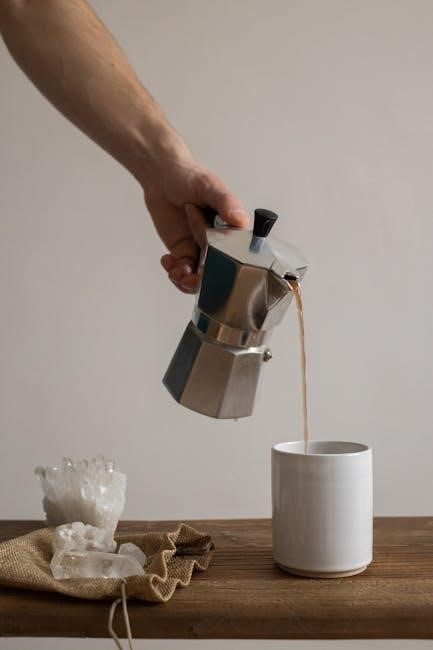
Understanding the Importance of Regular Cleaning
Regular cleaning prevents mineral buildup, removes coffee residue, and maintains hygiene, ensuring your Bunn coffee maker performs optimally and delivers fresh, flavorful coffee consistently.

Preventing Mineral Buildup and Scaling
Mineral buildup, or scaling, is a common issue in Bunn coffee makers, especially in areas with hard water. Over time, minerals like calcium and lime deposit inside the machine, clogging water flow and reducing efficiency. Regular descaling with a vinegar-water solution helps dissolve these deposits, ensuring proper water circulation and maintaining the machine’s performance. For heavier buildup, commercial descaling solutions may be necessary. Consistent cleaning prevents scaling from becoming a serious problem, keeping your coffee maker functioning smoothly and extending its lifespan.
Removing Coffee Oils and Residue
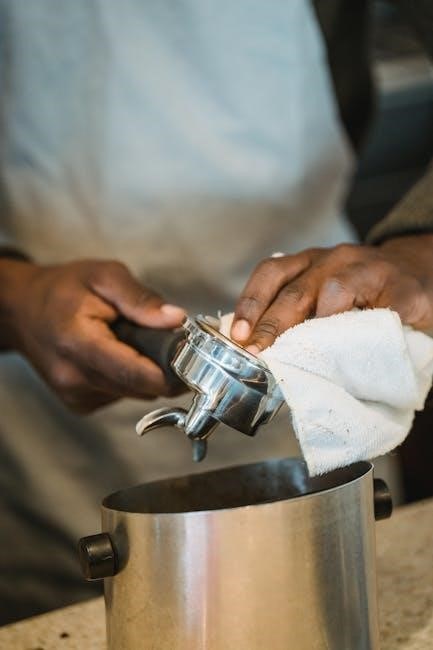
Coffee oils and residue can accumulate inside your Bunn coffee maker, leading to bitter flavors and reduced performance. Regular cleaning helps eliminate these buildup. A vinegar-water solution is effective for breaking down coffee oils, as it naturally dissolves residue without damaging the machine. Running a cycle with this solution ensures the interior is cleaned thoroughly. Afterward, rinsing with fresh water removes any lingering vinegar taste. Neglecting this step can result in old coffee residue affecting the flavor of future brews. Consistent cleaning maintains the machine’s efficiency and ensures every cup tastes fresh and delicious.
Maintaining Hygiene and Freshness
Regular cleaning is vital for maintaining hygiene and ensuring your Bunn coffee maker delivers fresh, flavorful coffee. Over time, bacteria and mold can grow in moist areas, affecting the taste and quality of your brew. Cleaning with a vinegar-water solution helps sanitize internal components and remove impurities. Descaling removes mineral deposits that can harbor bacteria. Wipe down the exterior with mild soap to eliminate surface germs. Cleaning the spray head and brew basket regularly prevents old coffee oils from causing stale flavors. Freshness is preserved by ensuring all parts are free from residue and contaminants, making every cup taste as good as the first.

Gathering Necessary Supplies for Cleaning
Essential supplies include white distilled vinegar, water, a cleaning tool for the spray head, and mild soap for the exterior. Optional descaling solutions may also be used.
White Distilled Vinegar and Water Solution
A mixture of equal parts white distilled vinegar and water is a common cleaning agent for Bunn coffee makers. This solution helps remove mineral buildup and coffee residue effectively. For descaling, fill the reservoir with the vinegar-water blend and run a brew cycle without coffee grounds. Repeat if necessary to ensure all scaling is removed. This method is cost-effective and gentle on the machine, promoting optimal performance and freshness in every brew. Always rinse thoroughly after cleaning to eliminate any vinegar taste.

Optional Descaling Solutions
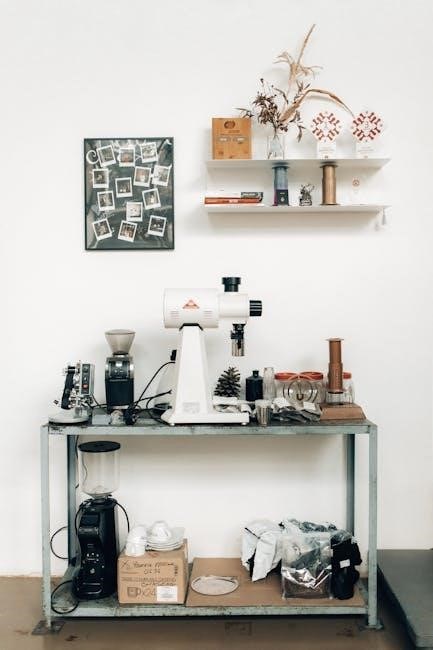
For heavy mineral buildup, commercial descaling solutions can be used as an alternative to vinegar. These products are specifically designed to break down and remove scaling effectively. While vinegar is a cost-effective option, descaling solutions are often faster and more thorough for severe cases. However, they can be harsher, so rinsing the machine thoroughly after use is crucial. Some users prefer eco-friendly or enzyme-based cleaners, which are gentler on the machine while still tackling tough buildup. Always follow the product instructions and rinse multiple times to ensure no residue remains.
Cleaning Tools for Spray Heads and Exterior
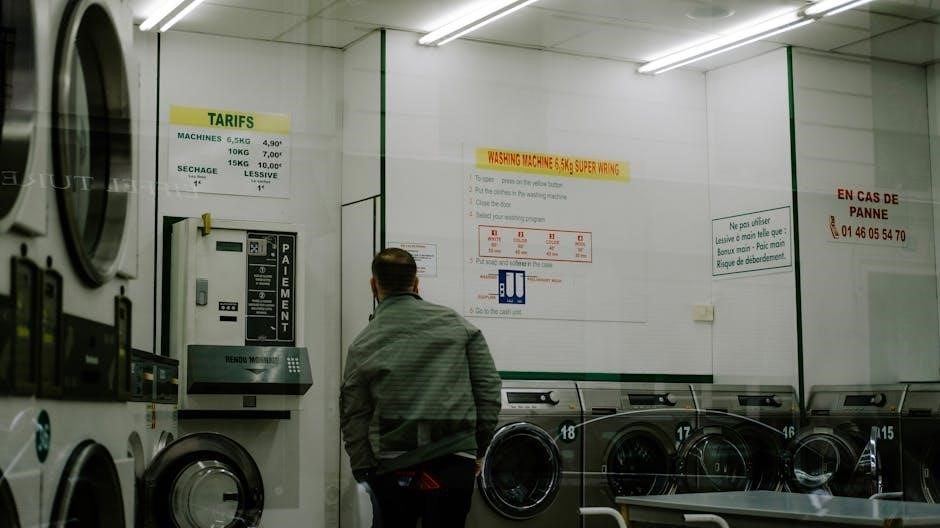
Specialized tools like the Bunn spray head cleaning tool are essential for removing mineral buildup and clogs in spray heads. A soft-bristle brush or toothbrush can gently scrub the exterior to remove coffee oils and stains. For tougher buildup, a mixture of mild soap and water can be applied to the exterior before wiping clean with a damp cloth. Regular cleaning of these areas ensures optimal water flow and prevents bacterial growth, maintaining the machine’s efficiency and hygiene. Always use gentle cleaning products to avoid damaging the coffee maker’s surfaces.
Step-by-Step Cleaning Process
Prepare your Bunn coffee maker, run a vinegar-water cycle, rinse thoroughly, clean the spray head and brew basket, and dry the machine to ensure optimal performance.
Preparing the Coffee Maker for Cleaning
Before cleaning, turn off and unplug your Bunn coffee maker for safety. Remove any remaining water from the reservoir and discard used coffee grounds. Ensure the machine is cool to avoid burns. This preparation step ensures a smooth and effective cleaning process without any hazards or interruptions.
Cleaning the Exterior with Mild Soap
Cleaning the exterior of your Bunn coffee maker involves using a mild soap solution to maintain its appearance and hygiene. Dampen a clean cloth with a mixture of warm water and a small amount of mild dish soap. Gently wipe down the machine’s surfaces, paying attention to areas with visible stains or splatters. Avoid using harsh chemicals, abrasive scrubbers, or excessive water, as these could damage the finish or seep into internal components. After cleaning, use a damp, clean cloth to remove any soap residue, then dry the exterior thoroughly with a dry cloth to prevent water spots and maintain the machine’s finish.
Running a Vinegar-Water Solution Cycle
Running a vinegar-water solution cycle is crucial for descaling and cleaning the internal components of your Bunn coffee maker. Mix equal parts white distilled vinegar and water. Pour the solution into the water reservoir, ensuring it reaches the recommended fill level. Place an empty carafe in the drip area. Turn on the machine and allow it to complete a full brew cycle. The vinegar solution will help remove mineral buildup and coffee residue from the internal water pathways. Repeat the process if you notice scaling or if the machine hasn’t been cleaned in a while. This step ensures optimal water flow and flavor.
Rinsing the Machine Thoroughly
Rinsing your Bunn coffee maker thoroughly is essential after cleaning to remove any lingering vinegar taste or residue. Fill the water reservoir with fresh, cold water and run 2-3 complete brew cycles to flush out the system. After each cycle, discard the water from the carafe and repeat until the water runs clean. This step ensures no vinegar flavor remains, which could affect the taste of future brews. Additionally, rinse the brew basket and carafe with warm soapy water to eliminate any cleaning solution residue. Proper rinsing guarantees a fresh, clean taste in every cup of coffee.
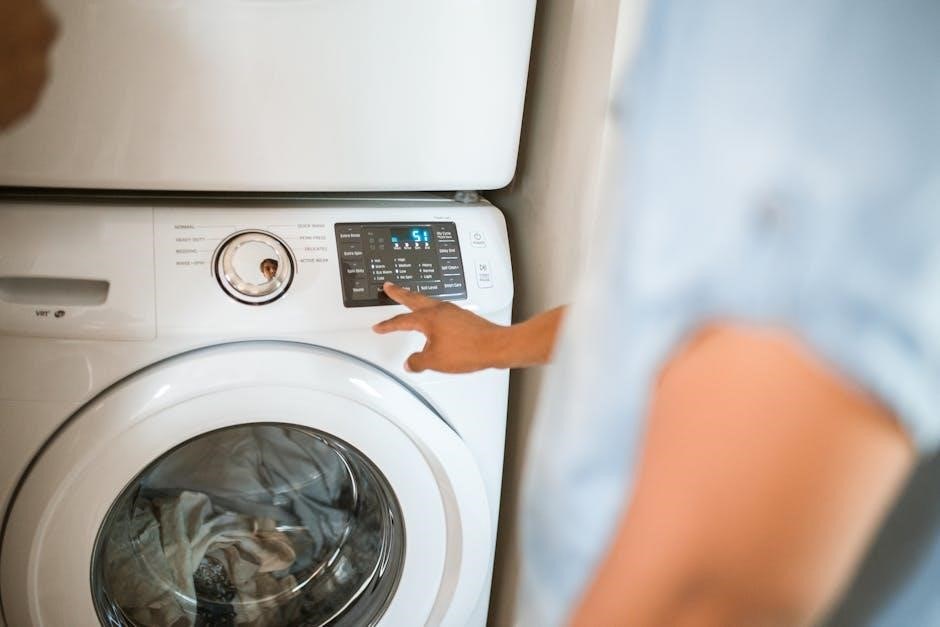
Cleaning the Spray Head and Brew Basket
Cleaning the spray head and brew basket is crucial for maintaining your Bunn coffee maker’s efficiency and hygiene. Use the Bunn spray head cleaning tool to clear any mineral buildup or residue from the spray head holes. Gently scrub the brew basket with a soft sponge and mild soap to remove coffee oils and stains. Rinse both parts thoroughly with warm water to ensure no cleaning solution remains. Regular cleaning of these components prevents clogs and ensures even water distribution during brewing, leading to a better-tasting coffee. This step also helps prevent bacterial growth and keeps your machine functioning smoothly.
Drying the Coffee Maker After Cleaning
Drying your Bunn coffee maker after cleaning is essential to prevent moisture buildup and bacterial growth. After rinsing, turn on the machine without coffee grounds to let it run a hot water cycle, ensuring all internal parts are dry. Use a clean, dry cloth to wipe down the exterior and brew basket. Allow the machine to air dry with the water reservoir lid open to prevent condensation. Regular drying helps maintain hygiene and prevents mineral deposits from forming due to leftover moisture. This step ensures your coffee maker remains in optimal condition for the next use.
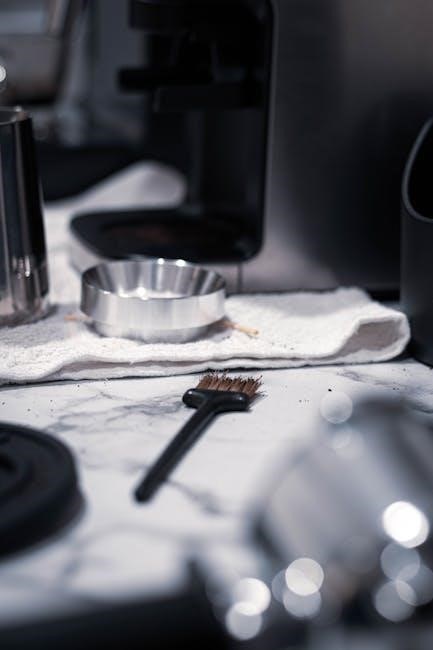
Cleaning Specific Bunn Coffee Maker Models
Different Bunn models require tailored cleaning approaches. The GR 10, AXIOM, and VP/Single-Dual SH models benefit from vinegar descaling, spray head cleaning, and regular maintenance for optimal performance.
Cleaning the Bunn GR 10 Model
Cleaning the Bunn GR 10 involves a simple process. Start by mixing a 1:1 ratio of white distilled vinegar and water. Fill the reservoir with this solution and run a full brew cycle. Repeat the process without the solution to rinse thoroughly. For deeper cleaning, use the Bunn spray head cleaning tool to clear any blockages. Regular descaling prevents mineral buildup, ensuring consistent performance. This model’s straightforward design, with only two buttons, makes maintenance easy. Always unplug the machine before cleaning to ensure safety. By following these steps, your GR 10 will continue to deliver great-tasting coffee.
Deep Cleaning the Bunn AXIOM Model
Deep cleaning the Bunn AXIOM model requires a thorough approach. Begin by descaling using a 1:1 ratio of white vinegar and water. Fill the reservoir and run two full brew cycles to ensure all internal parts are cleaned. For tougher buildup, use a commercial descaling solution as directed. Next, clean the spray head with the Bunn cleaning tool to remove any blockages. Wipe down the exterior with a damp cloth and mild soap. Rinse the machine by running multiple water cycles to eliminate any vinegar taste. Regular deep cleaning will maintain the AXIOM’s performance and ensure your coffee tastes its best every time.
Maintenance Tips for VP and Single/Dual SH Models
For Bunn VP and Single/Dual SH models, regular maintenance is key to extending their lifespan. Start by descaling every 3-6 months using a 1:1 vinegar-water solution. Run two full cycles to ensure all internal components are cleaned. For the Single/Dual SH, use the Bunn spray head cleaning tool to clear any blockages in the spray head. Wipe the exterior daily with a damp cloth to prevent dust buildup. After descaling, rinse thoroughly by running multiple water cycles to remove any vinegar taste. Regular cleaning and descaling will keep your VP or SH model functioning optimally and brewing great-tasting coffee consistently.
Deep Cleaning and Descaling
Deep cleaning and descaling are crucial for removing stubborn mineral buildup and coffee oils. Use a vinegar-water solution or descaling products to ensure optimal performance and longevity.
Using Descaling Solutions for Heavy Mineral Buildup
For severe mineral buildup, specialized descaling solutions are effective. Fill the reservoir with a mix of one part descaler to three parts water. Run a full brew cycle, then rinse thoroughly with fresh water to remove any solution residue. Repeat if necessary to ensure all scaling is removed. This process prevents clogs and maintains water flow efficiency, ensuring your Bunn coffee maker continues to perform optimally. Always follow the manufacturer’s instructions for best results and to avoid damaging the machine.
How to Use the Bunn Spray Head Cleaning Tool
To clean the spray head, detach it from the machine. Insert the Bunn spray head cleaning tool into the openings and gently move it back and forth to clear any blockages. Rinse the spray head with warm water to remove loosened debris. For thorough cleaning, soak the spray head in a mixture of equal parts water and white vinegar for about 30 minutes. After soaking, rinse thoroughly and reattach it to the machine. Regular cleaning ensures even water distribution and prevents mineral buildup, maintaining optimal brewing performance and flavor.
Maintenance and Troubleshooting
Regular cleaning and descaling are crucial for preventing issues. Check for blockages in water flow and spray heads. Use vinegar solutions for mild scaling and odor control.
Identifying and Solving Scaling Issues
Scaling issues occur due to mineral buildup from water. Signs include reduced water flow, slower brewing, or unusual noises. To address this, run a vinegar-water solution through the machine to dissolve minerals. For severe scaling, use a commercial descaling product. After cleaning, rinse thoroughly to remove any residue. Regular descaling prevents long-term damage and ensures optimal performance. If scaling persists, check the water filter or consider using filtered water to reduce mineral content. Proper maintenance helps extend the life of your Bunn coffee maker and keeps it functioning efficiently.
Reducing Odors and Bacterial Growth
Odors and bacterial growth in Bunn coffee makers can be managed through regular cleaning. After each use, empty the brew basket and discard used grounds. Wipe down surfaces with a damp cloth to remove residue. Running a vinegar-water solution through the machine helps eliminate internal odors and bacteria. For tougher odors, mix equal parts water and white vinegar, then run a full brew cycle. Repeat if necessary. Always rinse thoroughly after cleaning to ensure no vinegar taste remains. Keeping the machine dry after use also prevents moisture buildup, which can foster bacterial growth and unpleasant smells.
Regular cleaning and descaling are vital for your Bunn coffee maker’s longevity. Use vinegar solutions, clean accessories, and dry thoroughly to maintain optimal performance and freshness.
Best Practices for Long-Term Maintenance
Consistency is key to maintaining your Bunn coffee maker. Regularly descale using a vinegar-water solution, clean the spray head, and wipe down the exterior. Replace worn parts promptly. Always rinse thoroughly after cleaning to prevent vinegar taste. Store the machine in a dry place to avoid moisture buildup. For commercial models, follow the manufacturer’s specific descaling recommendations. By adhering to these practices, you ensure your Bunn coffee maker continues to deliver great-tasting coffee for years to come.
Ensuring Your Bunn Coffee Maker Lasts Longer
Regular maintenance is vital to extend the life of your Bunn coffee maker. Clean the exterior with mild soap and water, and descale every 1-2 months using a vinegar-water solution. Use the Bunn spray head cleaning tool to remove buildup. After cleaning, dry the machine thoroughly to prevent mineral deposits. Replace worn-out parts like gaskets and seals promptly. For commercial models, follow the manufacturer’s descaling recommendations to avoid damage. By prioritizing consistent care, you’ll enjoy optimal performance and a longer lifespan for your Bunn coffee maker.
